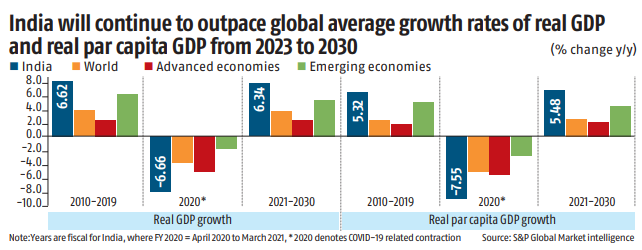ForumIAS announcing GS Foundation Program for UPSC CSE 2025-26 from 27th May. Click Here for more information.
Source: The post is based on the article “Aiming for the high road” published in the Business Standard on 4th May 2023.
Syllabus: GS – 3: Indian Economy and issues relating to planning, mobilization, of resources, growth, development and employment.
Relevance: About India’s growth rate.
News: The investors who put substantial capital into China in its early growth phase are finding similar patterns mirrored in India that encourage their investment. These investors are looking to limit or reduce new investments in China and invest such funds in emerging markets such as India.
What are the challenges affecting India’s growth rate?

The issue with government spending: India has lost opportunities and made misplaced choices with growth coming from government spending. Instead of focusing on structural changes to provide lower-cost infrastructure and efficient governance, the government chose corporate tax cuts.
This has led to a) a constrained, uncompetitive private sector hindered by disabling regulations, b) inadequate and unreliable infrastructure, c) limited capital access, d) tariff barriers, e) an inappropriate and ineffective educational approach for employability and improving skills, and f) impoverishment among much of the population.
Project delays and rapid deterioration of roads: Infrastructure project delays as of March 2023 were reportedly the highest since 2004. These include nearly 57% of projects over ~150 crores. Thus resulting in a cost escalation of over 20%, amounting to half this year’s capital expenditure budget.
Heavy rains aggravate the problem of the deterioration of roads. Countries with equally severe weather variations build and maintain better roads.
What should be done to improve India’s growth rate?
India’s policy towards logistics and digital transformation has started yielding results. Despite the drawbacks, India is still in a sweet spot because of its economic resilience, momentum, favourable demographics and improving productivity. India should utilise these better. Such as,
-India should begin with policies that a) provide a reliable infrastructure that is affordable, b) improve capital access, and c) eliminate “tax terrorism”.
-India should enable more people, including more women and young people, to participate and contribute to the economy.
-The government should also assure a sense of security with law and order for private firms, enhance access to meaningful education and skill building, make deep changes to make “extensive” agriculture into an intensive, informed approach.
-Facilitate productivity revolution: If people got access to fast, reliable 4G-level connectivity countrywide, then, there would likely be a productivity revolution. Widespread fibre-to-the-home is unrealistic because of the cost. So, India needs enabling policies for these. India should also build shared neutral host networks (NHNs), which are the most efficient, and reduces active sharing by operators costs 70% less per user.




